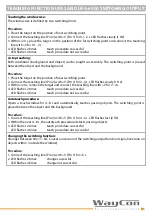
INFLUENCES ON THE MEASUREMENT
Environmental influences:
Ultrasonic sensors are made for the use in atmospheric air. Environmental Influences like rain, snow,
dust or smoke have no influence on the accuracy of the measurement. However, measurements under
pressure (higher that the atmospheric pressure) are not possible with ultrasound sensors.
Strong wind or air turbulences may lead to instability in measurement values. A flow speed up to a few
m/s is unproblematic and will have no influence on the sensor’s accuracy.
Target Influences:
• Liquids
are excellently detectable with ultrasound. A classic application for ultrasonic sensors is level
measurement. The sound beam axis however must have a maximum deviation of 3° vertically to the
liquid level (no strong waves), otherwise the reflected sound will miss the sensor.
• Hot Targets
with high temperatures cause a thermal convection in the surrounding air. For this
reason the sound beam may be strongly diverted vertically to its axis, so that the echo is weakened,
or can no longer be received at all.
• For convex (cylindrical and spherical) surfaces
every area element has a different angle to the sound
cone’s axis. The reflected cone thus diverges and the portion of the sound energy reflected to the
receiver is reduced correspondingly. The maximum range decreases with the decreasing size of the
cylinder (ball).
• The roughness and surface structures of the object
to be detected also determine the scanning
capacities of the ultrasonic sensors. Surface structures that are larger than the ultrasound
wavelength, as well as coarse-grained bulk materials, reflect ultrasound in a scattered manner, and
are not detected optimally by the sensor under these conditions.
• Hard material
reflects almost all of the impulse energy from ultrasound applications in a way that
makes them very easy to detect with ultrasound.
• Soft material,
on the other hand, absorbs almost all of the impulse energy. It is thus harder to detect
with ultrasound. These materials include felt, cotton, coarse meshes, foam, etc.
• Thin-walled foils
behave like soft materials. To be able to use ultrasound, the foil thickness should
be at least 0.01 mm.








